I was riding along minding my own business when a Monarch started flying along next to my shoulder. It sometimes took the lead – sometimes lagged back or flitted into a bush – but it stayed there for more than a mile. What a beautiful companion.
Monarchs seem to be everywhere this year: on bike trails, in meadows, at the beach, on city streets. They are like little bits of art floating on the breeze.
I have been able to closely observe the miracle of metamorphosis this year. It was fascinating 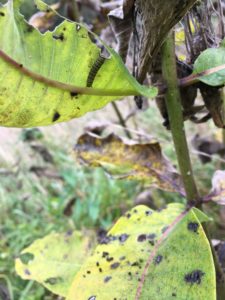 tracking a tiny one-centimeter long caterpillar as it grew to be big and fat. And then watching it decimate an entire Milkweed plant. Leaving the Milkweed, it climbed down and back up a blade of stiff grass, anchored itself, and then magically turned into a chrysalis.
tracking a tiny one-centimeter long caterpillar as it grew to be big and fat. And then watching it decimate an entire Milkweed plant. Leaving the Milkweed, it climbed down and back up a blade of stiff grass, anchored itself, and then magically turned into a chrysalis.
The chrysalis seemed to stay there forever doing nothing but, if closely observed, the chrysalis was at first doughy looking, light filled, and pale green. Then, as it aged, the chrysalis seemed to harden, have sharper edges, and deepen in color. Then, just as magically, the chrysalis was e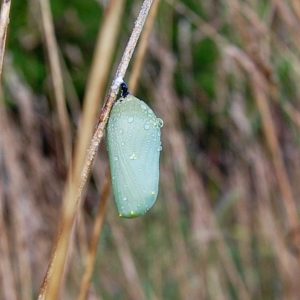 mpty,
mpty, 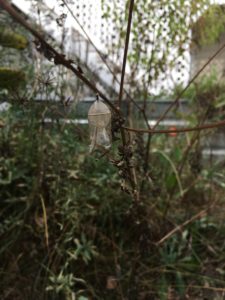 no more caterpillar, not even a butterfly, just a diaphanous bit of silk fluttering in the breeze.
no more caterpillar, not even a butterfly, just a diaphanous bit of silk fluttering in the breeze.
Spotting caterpillars has become a bit of an obsession. They aren’t always easy to see but the droppings are pretty obvious. Little piles of brown, corrugated cylinders fall to the leaf below the caterpillar as it gnaws away. Find those piles and then look under the leaf above – Voila!
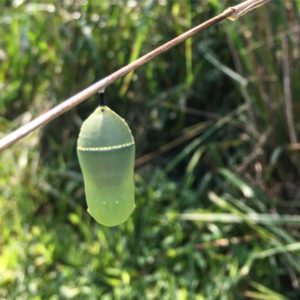 It seems like finding a chrysalis would be easy. That beautiful, emerald green color decorated with gold, the chrysalis, looks almost like a miniature sari. But they also look like little leaves and blend easily into the foliage. Serendipity may be the best way to find them…but…. Sherlock Holmes might be more scientific in his search.
It seems like finding a chrysalis would be easy. That beautiful, emerald green color decorated with gold, the chrysalis, looks almost like a miniature sari. But they also look like little leaves and blend easily into the foliage. Serendipity may be the best way to find them…but…. Sherlock Holmes might be more scientific in his search.
Holmes would probably look for caterpillar droppings and decimated Milkweed. He might then calculate how far a fully-grown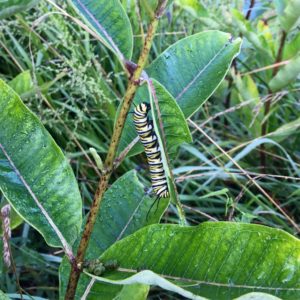 caterpillar could crawl. Then he would check wind conditions: the caterpillar wants the chrysalis to have some air flow but it can’t be too windy so that it will stay put. The caterpillar also wants a spot that allows the butterfly to dry its wings after it emerges. A location with a nice breeze is great for this. With all of this information Sherlock would probably move two or three plants away to an arching branch and then spotting one, he would shout “Aha!”.
caterpillar could crawl. Then he would check wind conditions: the caterpillar wants the chrysalis to have some air flow but it can’t be too windy so that it will stay put. The caterpillar also wants a spot that allows the butterfly to dry its wings after it emerges. A location with a nice breeze is great for this. With all of this information Sherlock would probably move two or three plants away to an arching branch and then spotting one, he would shout “Aha!”.
What surprised me this year was how many Monarchs were zipping around. Perhaps the resistance efforts against Monsanto’s chemicals/ products and advocacy groups such as MonarchWatch may 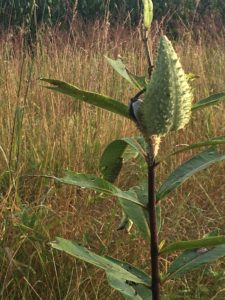 be increasing awareness of the Monarchs’ plight. Monarchs are like the Canary in the coal mine showing us through their decline where habitat is being destroyed through development and big agriculture and degraded through use of crop seed that is genetically modified to contain pesticides and herbicides.
be increasing awareness of the Monarchs’ plight. Monarchs are like the Canary in the coal mine showing us through their decline where habitat is being destroyed through development and big agriculture and degraded through use of crop seed that is genetically modified to contain pesticides and herbicides.
Imagine you are in a hurry to get somewhere and miss a placard that warns the building you are entering has just been fogged or bombed with pesticides designed to attack the nervous systems of roaches. Inside you think it smells odd but don’t know why. You spend a little bit of time inside breathing in the poisons. You will get sick. You may even die from that exposure.
Now imagine you are a Monarch caterpillar munching away on a Milkweed plant. This one is dusted with pollen from the neighboring corn field. Very tasty. That pollen may contain pesticides and you are a pest. You munch away never knowing that the GMO pollen is causing you to grow slower than normal, then you feel ill and then maybe you die before you can metamorphosize. Be you human or Monarch it is pretty much impossible to differentiate organic versus GMO corn.
Now imagine you are the butterfly flying from Mexico to Pennsylvania. You ate a lot before you left but need to stop a few times along the way to eat and restore your energy. Only problem is that the farm field edges are mowed or farmed and new developments have sprung up where fallow fields used to be. The pollen and nectar sources have disappeared and your energy lapses making the trip nearly impossible. This has been the experience of the Monarch for many years but things may be changing.
I am beginning to see Common and Swamp Milkweed, the larval (caterpillar) food for Monarch’s, interspersed with bedding plants in front yard gardens. This is really saying something because once the Monarch is finished with the Milkweed it looks bedraggled at best; messiness is not normally tolerated by many gardeners. The spread of Milkweed is significant because the loss of breeding habitat is one of the main reasons for decline in Monarch populations. For more detailed information see the Monarch Conservation Plan and the Federal government’s effort to Save the Monarch program.
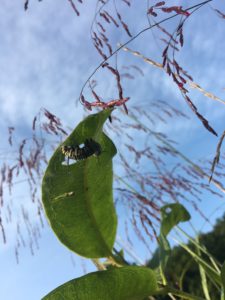 A wonderful way to garden for Monarch’s is to seed Milkweed before winter into the back or mid-border. The seeds want to be in place for the winter. Common Milkweed will grow just about everywhere and can get quite tall (26-36”). Swamp Milkweed does need a bit of moisture to be happy. It is slightly more elegant looking and slightly shorter than the common. The caterpillars love
A wonderful way to garden for Monarch’s is to seed Milkweed before winter into the back or mid-border. The seeds want to be in place for the winter. Common Milkweed will grow just about everywhere and can get quite tall (26-36”). Swamp Milkweed does need a bit of moisture to be happy. It is slightly more elegant looking and slightly shorter than the common. The caterpillars love 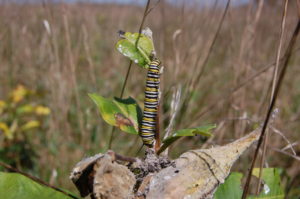 both. The metamorphized butterfly needs nectar from flowers. When planning the garden think about how big a Monarch is and add flowers with nice landing pads like native Sunflower,
both. The metamorphized butterfly needs nectar from flowers. When planning the garden think about how big a Monarch is and add flowers with nice landing pads like native Sunflower,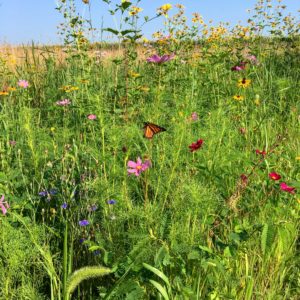 Cosmos, Goldenrod, and Black-eyed Susan; provide the food sources that they need and you will be rewarded with the beautiful sight of orange flashes in the garden.
Cosmos, Goldenrod, and Black-eyed Susan; provide the food sources that they need and you will be rewarded with the beautiful sight of orange flashes in the garden.
I have been surprised by those flashes practically everywhere – in gardens on Pawleys Island, SC; along the West Side Bike Path in New York City; throughout Center City Philadelphia; hiding in the Smithsonian Gardens in Washington, DC; on the beach in Lewes, DE.
Filled to the brim with nectar, the Monarchs have started toward their winter resting place in Mexico. Check out the Journey North migration map to see how the journey is going.
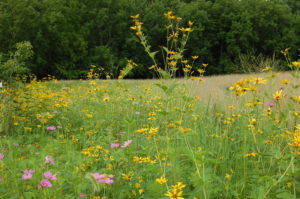 The meadow that I have written about contains about an acre of Milkweed sprinkled across the field. It is complemented with nectar flowers that make for a beautiful, albeit large garden. I hope that the idea of seeing winged orange flashes in your garden inspires you to plan and plant for the Monarchs and then, like Sherlock, stalk them and watch as they hatch, munch, grow, hide, metamorphize, escape, flit, sip and fly away south. Working together we can provide habitat for these very beautiful creatures and at the same time create a more beautiful, sustainable, and healthy habitat for ourselves.
The meadow that I have written about contains about an acre of Milkweed sprinkled across the field. It is complemented with nectar flowers that make for a beautiful, albeit large garden. I hope that the idea of seeing winged orange flashes in your garden inspires you to plan and plant for the Monarchs and then, like Sherlock, stalk them and watch as they hatch, munch, grow, hide, metamorphize, escape, flit, sip and fly away south. Working together we can provide habitat for these very beautiful creatures and at the same time create a more beautiful, sustainable, and healthy habitat for ourselves.
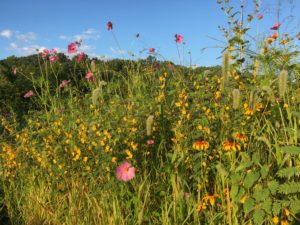
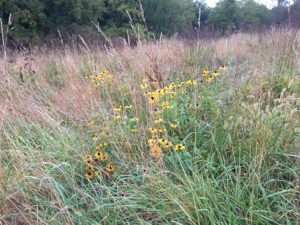 Hopefully you too will be treated to a bike ride with a Monarch.
Hopefully you too will be treated to a bike ride with a Monarch.

